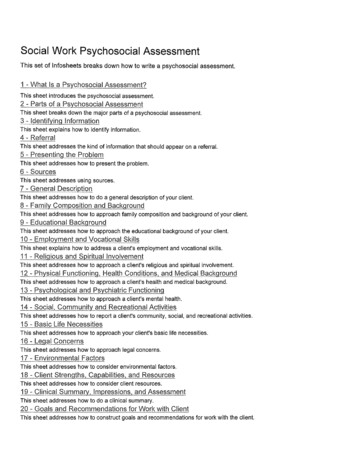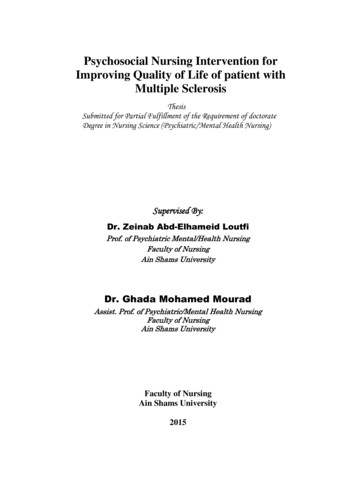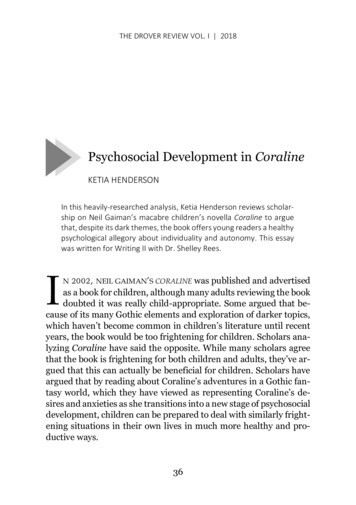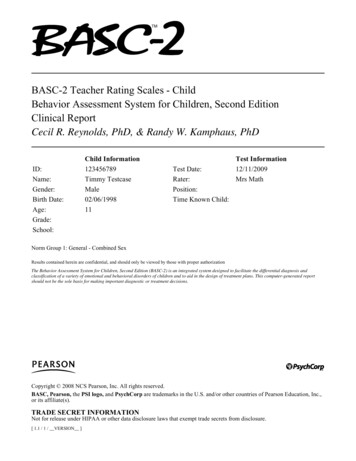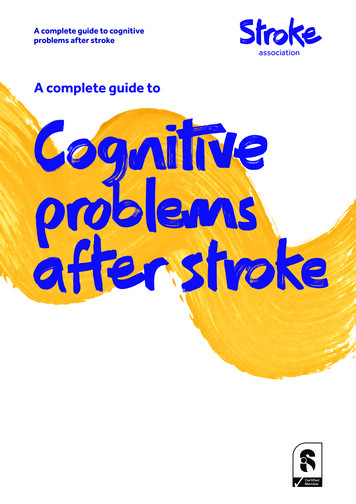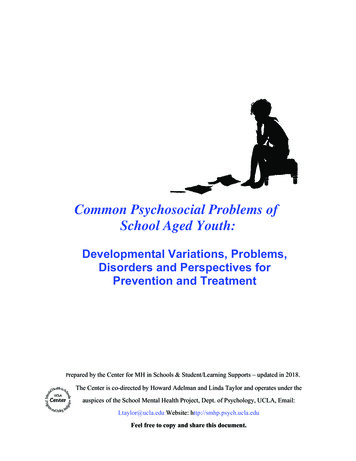
Transcription
Common Psychosocial Problems ofSchool Aged Youth:Developmental Variations, Problems,Disorders and Perspectives forPrevention and TreatmentPreparedby the Center for MH in Schools & Student/Learning Supports – updated in 2018.The Center is co-directed by Howard Adelman and Linda Taylor and operates under theauspices of the School Mental Health Project, Dept. of Psychology, UCLA, Email:Ltaylor@ucla.edu Website: http://smhp.psych.ucla.eduFeel free to copy and share this document.
ContentsPrefaceIntroduction: Mental Health in Schools1Time for Straight Talk about Mental Health Services and MH in Schools2Moving Forward: MH in Schools & Student/Learning Supports4I. Keeping the Environment in Perspective as a Cause of Commonly Identified 10Psychosocial ProblemsA. Labeling Troubled and Troubling Youth11B. Environmental Situations and Potentially Stressful Events14II. A Full Range of Programs to Address Behavioral, Emotional, and LearningProblemsA. A Continuum of Community-School Programs: PrimaryPrevention Through TreatmentB. Accommodations to Reduce ProblemsC. Developing Systems at a School for Problem Identification,Triage, Referral, and Management of CareD. Treatments for Psychosocial Problems and Disorders1616192729III. Frequently Identified Psychosocial Problems: DevelopmentalVariations, Problems, Disorders, and InterventionsA. Attention ProblemsB. Conduct and Behavior ProblemsC. Anxiety ProblemsD. Affect and Mood ProblemsE. Social and Interpersonal Problems31IV. Increasing the School’s Capacity to Prevent and Ameliorate ProblemsA. Capacity Building for Teachers and School StaffB. The Role of Support StaffC. Forming Partnerships with ParentsD. Fostering Students’ Social and Emotional DevelopmentE. Student and Learning Supports: Increasing Availability andEnhancing Access and Use1003244627696110112119120122
PrefaceSchool systems are not responsible formeeting every need of their students.But when the need directly affectslearning the school must meet thechallenge.Carnegie Council onAdolescent Development, 1989Estimates of the number of school aged childrenwith emotional problems vary. Incidence andprevalence figures are controversial, with estimatesranging from 2-3% to 22%. For a critiqueof current data, see the Center's 2018document Youngsters’ Mental Health andPsychosocial Problems:What are the /youthmh.pdfThe numbers increase when those referred to as at risk are included. Researchsuggests, however, that there are a considerable number of false positivemisdiagnoses (i.e., the labeling of youngsters who do not have true disabilities/disorders). What is clear is that schools can accomplish their goal of teaching onlywhen they have addressed the psychosocial problems that interfere with students'learning.In schools, youngsters with serious emotional and learning problems usually areassisted under the auspices of "special education." Of course, many students withbehavior, learning, and emotional problems don't meet the criteria for specialeducation. Their needs must be addressed through support programs and otheraccommodations.This resource provides frameworks and strategies to guide schools as they encountercommon psychosocial problems.It is designed as a desk reference aid.After an introductory overview of mentalhealth in schools: Part I stresses ways to keep theenvironment in perspective as a cause ofcertain types of problems. Part II frames the full range of programsthat allow a school and communityto address psychosocial problems. Part III covers five of the most common"syndromes" students manifest andschools agonize over: attention problems conduct and behavior problems anxiety problems affect and mood problems social/interpersonal problems Part IV explores ways to increase a school’scapacity to prevent and ameliorate problems.i
To provide a normalizing perspective, the descriptions adopted are those usedin the1996 American Academy of Pediatrics’ manual (The Classification ofChild and Adolescent Mental Diagnoses in Primary Care --DSM-PC).This framework differentiates developmental variations, problems, anddisorders in ways that provide a good basis for identifying minor developmentaldifferences and early symptoms so that minor concerns can be prevented fromescalating into major disorders. Following this discussion, the focus is onintervention -- emphasizing use of "accommodations" as a first strategy andthe role of empirically supported treatments.At the UCLA Center for MH in Schools & Student/Learning Supports, we havedeveloped a variety of materials relevant to specific problem areas and for schoolimprovement. See the Online Resource Catalogue -- m Online Clearinghouse Quick Finds – http://smhp.psych.ucla.edu/quicksearch.htm Center Website Search – http://smhp.psych.ucla.edu/websrch.htmii
IntroductionMental Health in Schools1
Time for Straight Talk about Mental Health Services and MH in SchoolsWhen you hear the term Mental Health in Schools or School Mental Health,what comes to mind?Probably you think about students who have psychological problems, about what servicesthey need, and how schools don’t provide enough of such services. This is not surprising given thewidespread tendency for the term mental health to be thought of as referring to mentaldisorders/illness and for relevant interventions to be seen as services (e.g., counseling/therapy).As a result, many well-intentioned initiatives and policy reports have focused on expanding mentalhealth services in schools. Bluntly stated, however, advocacy for more mental health services inschools often detracts from efforts to encourage policy makers to address the full range of mentalhealth concerns confronting school staff, students, and their families.Our analyses of policy and practice stress understanding the following matters as key to advancinga broad approach to mental health in schools.* The concept of mental health encompasses a continuum of concerns ranging frompromoting positive social and emotional development to treating mental disorders. Mental health problems are fully enmeshed with psychosocial and educational problems. Given the above, schools have a role to play in (a) promoting positive mental health (e.g.,social-emotional development), (b) preventing learning, behavior, and emotionalproblems, (c) intervening as early as feasible when such problems arise, and (d) treatingsevere and chronic problems. However, since the mission of schools is education, a mental health agenda (andespecially a clinical services agenda) by itself is too narrow to be a high priority for oursociety’s schools.Those concerned with enhancing the role of mental health in schools must guide policy makersto a clear understanding of the many factors that are interfering with learning and teaching the large number of students who are experiencing learning, behavior, and emotionalproblems the fragmented and marginalized state of affairs related to the limited set of services,programs, and initiatives currently provided as student/learning supports the small proportion of students reached the counterproductive competition for sparse resources.All the above realities work against enhancing every student’s civil right to equity of opportunityfor success at school and beyond.Given all this, it is time to focus on transforming student/learning supports. Doing so is fundamentalto improving intervention effectiveness in ways that enhance equity of opportunity, promote wholechild development, and engender a positive school climate. Doing so requires ending themarginalization of student/learning supports in school improvement policy and then framing andoperationalizaing them as a unified, comprehensive, and equitable system that weaves togetherschool and community resources.2
In the process, a broad definition of mental health in schools can be embedded into a transformedsystem of student/learning supports. Doing so will help reduce the unrealistic and often inappropriate call for more and more one-on-one directservices counter the mistaken view that collocating community services on school campuses canever be a sufficient approach to filling critical intervention gaps at schools and forenhancing community and home engagement increase classroom, school-wide, and community interventions that can reduce the needfor one-on-one services facilitate the weaving together of school, home, and community resources to gaineconomic benefits and enhance outcomes enhance coordination and cohesion of all resources (school, community, family) intendedto support young people.The bottom line in terms of equitable policy is that we cannot continue to provide a small numberof sites with a few more health and social services to establish a few islands of excellence(demonstrations, pilots) and “Cadillac models.” The scale of need demands moving quickly infundamentally new directions. With over 90,000 public schools in the U.S.A. and so many studentswho are not doing well, it is time to embed mental health in schools into a unified, comprehensive,and equitable system of learning supports. This will enhance the fit with the mission of schools andcontribute in a powerful way to schools playing a role in fully promoting social-emotionaldevelopment and comprehensively addressing barriers to learning and teaching.*For further elaboration of these points, see Adelman, H.S. & Taylor, L. (2010). Mental Health in Schools: Engaging Learners, PreventingProblems, and Improving Schools. Thousand Oaks, CA: Corwin Press. Adelman, H.S. & Taylor, L. (2012). Mental Health in Schools: Moving in New Directions.Contemporary School Psychology. f Embedding Mental Health into a Learning Supports Component: An Essential Step for the Field toTake Now. http://smhp.psych.ucla.edu/pdfdocs/embeddingmh.pdf Adelman, H.S. & Taylor, L. (2017). Addressing Barriers to Learning: In the Classroom andSchoolwide. access from the Center's homepage at http://smhp.psych.ucla.edu/ Adelman, H.S. & Taylor, L. (2018). Transforming Student and Learning Supports: Developing aUnified, Comprehensive, and Equitable System. San Diego: Cognella student-and-learning-supports-9781516512782.html Adelman, H.S. & Taylor, L. (2018). Improving School Improvement. Free access from the Center'swebsite at http://smhp.psych.ucla.edu/improving school improvement.html Adelman, H.S., Taylor, L., Mayer, M.J., & Dwyer, K.P. (in press). Intersection of School Safety,Mental Health and Wellness, and Family/Community Issues. In D. Osher, M. Mayer, R. Jagers,K. Kendziora, & L. Wood (Eds). Keeping Students Safe and Helping Them Thrive. Santa Barbara:ABC-CLIO.and the resources cited as part of the National Initiative for Transforming Student and Learning Supports –http://smhp.psych.ucla.edu/newinitiative.html .Send comments, questions, and requests to Ltaylor@ucla.edu .3
Moving Forward: MH in Schools & Student/Learning SupportsOver the last decades, research findings have made it evident that any initiative to expand the school'srole in addressing mental health concerns will be marginalized if it is not fully integrated into schoolimprovement policy and planning.Current school policy proclaims the aim for every student to succeed, and those proposing schoolbased interventions must recognize the full implications of the word every. An intervention focus onall students requires addressing the problems of the many youngsters who aren't benefitting frominstructional reforms because of a host of external and internal barriers interfering with theirdevelopment and learning and that are reflected in the wide range of psychosocial and mental healthconcerns school must cope with each day.Enhanced school-community collaboration is essential, but the narrow focus on expanding schoolbased mental health services (including colocating agency resources at schools) is not a viableapproach. The limited impact of various initiatives to link health and social services havedemonstrated this reality. Simply stated, a mental health services orientation doesn't account for thefull continuum of interventions needed to promote mental health and prevent and treat psychosocialand mental health problems.For many years, our Center's policy analyses have stressed ways to enhance the school's role relatedto mental health concerns by embedding mental health into school improvement policy and practice.In 2015, the Center established the National Initiative for Transforming Student and learning Supports-- see http://smhp.psych.ucla.edu/newinitiative.html . In 2017, to more fully underscore the breadth ofthe work, the Center name was expanded; the name is now the Center for MH in Schools &Student/Learning Supports.Given our expanded focus, we want to encourage Center users concerned about mental health inschools to avail themselves of a wide range of resources for addressing barriers to learning andteaching and re-engaging disconnected students. With this in mind, we are no longer updating thefollowing Sampling of References Related to Mental Health in Schools. While the list will no longerbe updated, it remains a useful resource so we are simply archiving it.In place of such a list, we are continuously updating our online clearinghouse Quick Finds.SO . for links to a wide range of relevant resources, we direct you to our Quick Finds. See the dropdown menu at http://smhp.psych.ucla.edu/quicksearch.htm .And when you need more, you can always do a regular Google search – https://www.google.com/?gws rd ssl#spf 1498966622326 a Google Scholar search -- http://scholar.google.com/4
ArchivedAn Sampling of References Related to Mental Health in Schools is included below:(In addition to what is included below, the Center has many more references, materials, andspecial resources relevant to MH in schools. Besides using the Center Quick Findshttp://smhp.psych.ucla.edu/quicksearch.htm which are updated regulary, also see the CenterResource List http://smhp.psych.ucla.edu/materials/resources.htm or contact the Center directly.)Major Reports on the Status of Mental Health in Schools& the Center's Perspective Taylor, L. & Adelman, H.S. (2013). Mental Health in Schools:Opportunities and Challenges. In The Prager Handbook ofCommunity Mental Health Practice. Praeger. Vol. 2, Chapter 5. Adelman, H.S. & Taylor, L. (2012). Mental Health in Schools:Moving in New Directions Contemporary School Psychology. Forpersonal use only. Adelman, H.S. & Taylor, L. (2010). Mental Health in Schools:Engaging Learners, Preventing Problems, and Improving Schools.Thousand Oaks, CA: Corwin Press. Center for Mental Health in Schools. (2008). Frameworks forSystemic Transformation of Student and Learning Supports LosAngeles: Author. Center for Mental Health in Schools. (2007). New Directions forStudent Support: Current State of the Art Los Angeles: Author. Center for Mental Health in Schools. (2006). Current Status ofMental Health in School: A Policy and Practice Analysis LosAngeles: Author. Advances in School-Based Mental Health Interventions: BestPractices and Program Models -- Editor: Vol 1: K.E. Robinson -Vol 2: S.W. Evans, M.D. Weist, S.N. Serpel. Civic ResearchInstitute. Kutash, K., Duchnowski, A.J. & Lynn, N. (2006). School-BasedMental Health: An Empirical Guide for s/study04/index.htm Cooper, J.L., Aratani,Y., Knitzer, J., et al. (2008) UnclaimedChildren Revisited: The Status of Children's Mental Health Policyin the United States.http://www.nccp.org/publications/pub 853.html Centers for Disease Control and Prevention (2013). Mental HealthSurveillance Among Children —United States, 2005–2011 Alegria, M., Green, J.G., McLaughlin, K.A., & Loder, S. (2015).William T. Grant Foundation.A Related National Report National Academies of Sciences, Engineering, and Medicine. 2015.Mental disorders and disabilities among low-income children.Washington, DC: The National Academies Press. Online5
Also see:National Initiative forTransforming Student and Learning Supports Summer Issue of Center's Quarterly e-journal/newsletter onTrailblazing Initiatives!Also view 30 minute Introductory webinarDownload accompanying PDf handouts2010-PresentBooksAdelman, H.S. & Taylor, L. (2017). Transforming Student and Learning Supports: Developing aUnified, Comprehensive, and Equitable System. Cognella PublishingAdelman, H.S. & Taylor, L. (2010). Mental Health in Schools: Engaging Learners, PreventingProblems, and Improving Schools. Thousand Oaks, CA: Corwin PressClauss-Ehlers, C.S., Serpell, Z.N., Weist, M.D. (Ed), Handbook of Culturally Responsive SchoolMental Health: Advancing Research, Training, Practice, and Policy. Springer New York.Dikel, W. (2014). The Teacher's Guide to Student Mental Health. W.W. Norton.Doll, B., Pfohl, W. & Yoon, J. (eds) (2010). Handbook of Youth Prevention Science. New York:Routledge.Forman, S.G. (2015). Implementation of Mental Health Programs in Schools: A change Agent Guide.Washington, DC: American Psychological Association.Furlong, M.J., Gilman, R. & Huebner, E.S. (eds) (2014). Handbook of positive psychology in schools.New York: Routledge/Taylor and Francis.Ghuman, H.S., Weist, M.D., Sarles, R.M. (Eds), Providing Mental Health Services to Youth WhereThey Are: School and Community Based Approaches. Routledge.Green, J., McLaughlin, K., Alegria, M., et al (2013). School mental health resources and adolescentmental health service use. Journal of the American Academy of Child & Adolescent Psychiatry, 52,501-510.Hess, R.S., Short, R.J., & Hazel, C.E. (2012). Comprehensive Children's Mental Health Services inSchools and Communities: A Public Health Problem-Solving Model (School-Based Practice inAction). RoutledgeLean, D.S. & Colucci, V.A. (2013). School-based Mental Health: A Framework for Intervention.Rowman & Littlefield.6
Macklem, G.L. (2014). Preventive mental health at school: Evidence-based services for students.New York : Springer.Rossen, E. & Hull, R. (Eds) (2012), Supporting and Educating Traumatized Students: A Guide forSchool-Based Professionals. New York: Oxford University Press.Shute, R. & S;ee, P. (2016). Mental Health and Wellbeing Through Schools. RoutledgeWalker, H.M. & Gresham, F.M. (eds) (2014). Handbook of evidence-based practices for emotionaland behavioral disorders: Applications in schools. New York: The Guilford Press.Waller, J. (ed) (2012). Mental Health Promotion in Schools. Sharjah, UAE: BenthemScience.Weist, M., Lever, N, Bradshaw C., & Owens, J. (ed.) (2014; 2nd ed.). Handbook of school mentalhealth: Research, training, practice, and policy. NY: Springer.Chapters/Articles (2010-present)Acosta, O.M., Tashman, N.A., Prodente, C., Proescher, E. (2013). Establishing successful schoolmental health programs: Guidelines and recommendations. In Ghuman, H.S., Weist, M.D., Sarles,R.M. (Eds), Providing Mental Health Services to Youth Where They Are: School and CommunityBased Approaches. Routledge.Adelman, H.S. & Taylor, L. (2014). Embedding School Health into School Improvement Policy.International Journal of School Health, 1. (epub)Adelman, H.S. & Taylor, L. (2014). Best Practices in the Use of Learning Supports Leadership Teamsto Enhance Learning Supports (pp.181-196). In Best Practices in School Psychology: System-LevelServices. The National Association of School PsychologistsAdelman, H.S. & Taylor, L. (2015). Immigrant Children and Youth in the U.S.A.: Facilitating Equityof Opportunity at School at School. Education Sciences (epub)Adelman, H.S. & Taylor, L. (2014). Not another special initiative! EveryChild Journal, 4, 74-80.(epub)Adelman, H.S. & Taylor, L. (2014). Addressing student and schooling problems: Not another project:Child safety should be embedded in the missions of schools Child Abuse & Neglect. (epub)Adelman, H.S. & Taylor, L. (2013). Enabling Component as Related to Mental Health. In D. Wyley& A. Cory (Eds.), Encyclopedia of School Health. Adelman, H.S. & Taylor, L. (2012). Mental Healthin Schools: Moving in New Directions. Contemporary School Psychology.Adelman, H. S. & Taylor, L. (2012). Student Engagement and Disengagement: An IntrinsicMotivation Perspective and a Mental Health Concern . In J. Waller (ed) Mental Health Promotion inSchools. Sharjah, UAE: BenthemScience.Adelman, H. S. & Taylor, L.(2012). Addressing trauma and other barriers to learning and teaching:Developing a comprehensive system of intervention. In E. Rossen & R. Hull (Eds), Supporting and7
Educating Traumatized Students: A Guide for School-Based Professionals. New York: OxfordUniversity Press. Chapter 18, pp. 265-286.Adelman, H. S. & Taylor, L. (2011). Expanding school improvement policy to better address barriersto learning and integrate public health concerns. Policy Futures in Education, 9(3).Adelman, H. S. & Taylor, L. (2010). Placing Prevention into the Context of School Improvement. InB. Doll, W. Pfohl, & J. Yoon (eds) Handbook of Youth Prevention Science. New York: Routledge.Atkins, M., Capella, E., Shernoff, E. et al. (2017). Schooling and children's mental health: Realigningresources to reduce disparities and advance public health. Annual Review of Clinical Psychology, Vol.13.Atkins MS, Hoagwood KE, Kutash K, Seidman E. (2010). Toward the integration of education andmental health in schools. Adm Policy Ment Health, 37, 40-47.Ballard KL, Sander MA, Klimes-Dougan B. (2013). School-related and social-emotional outcomes ofproviding mental health services in schools. Community Ment. Health J.Bershad, C., & Blaber, C. (2011). Realizing the Promise of the Whole-School Approach to Children’sMental Health: A Practical Guide for Schools. National Center for Mental Health Promotion andYouth Violence Prevention. Education Development CenterBuchanan, C.L.,Daly, B.P., Taylor, L.K., Weist, M.D., Wandersman, A. (2011). ExpandingInterdisciplinary Collaboration in School Mental Health: The Role of Graduate Programs. Emotional& Behavioral Disorders in Youth, 11, 67-72.Iachini, A.L., Anderson-Butcher, D., Mellin, E.A. (2013). Exploring best practice teaming strategiesamong school-based teams: implications for school mental health practice and research. Advances inSchool Mental Health Promotion. 6(2), 139-154.Iachini, A.L., Warren, M., Splett, J.W., George, M.W, Taylor, L.K., Weist, M.D. (2014). Exploringthe impact of a pre-service interprofessional educational intervention for school mental healthtrainees. Journal of Interprofessional Care.1-3.Mellin, E.A., Taylor, L., & Weist, M,D. (2014). The expanded school mental health collaborationinstrument [school version]: Development and initial psychometrics. School Mental Health, 6, 151162.Miller, L., Taha, L., Jensen, E. (2013). From guidance to school counseling: New models in schoolmental health. In Clauss-Ehlers, C.S., Serpell, Z.N., Weist, M.D. (Ed), Handbook of CulturallyResponsive School Mental Health: Advancing Research, Training, Practice, and Policy. SpringerNew York.Murray, M., McDaniel, H., Weist, M. (2013). Looking back and ahead for Advances in SchoolMental Health Promotion. Advances in School Mental Health Promotion. 6(3), 155-157.Pullman, M.D., Daly, B.P., Sander, M.A., Bruns, E.J. (2014). Improving the impact of school-basedmental health and other supportive programs on students' academic outcomes: How do we get therefrom here? Advances in School Mental Health Promotion. 7(1), 1-4.8
Taylor, L. & Adelman, H. S. (2013). Mental Health in Schools: Opportunities and Challenges. InMaller, D. (ed) The Praeger Handbook of Community Mental Health Practice. Praeger. Vol. 2,Chapter 5, pp. 85-100Taylor, L.K., Weist, M.D., Á Deloach, K. (2012). Exploring the Use of the Interactive SystemsFramework to Guide School Mental Health Services in Post-disaster Contexts: Building CommunityCapacity for Trauma-Focused Interventions. American Journal of Community Psychology.Walter, H.J., Gouze, K., Cicchetti, C., et al. (2011). A pilot demonstration of comprehensive mentalhealth services in inner-city public schools. J Sch Health, 81, 185-193.Zeng, G., Boe, E.E., Bulotsky-Shearer, R.J., Garrett, S.D., Slaughter-Defoe, D., Brown, E.D., &Lopez, B. (2013). Integrating U.S. Federal Efforts to Address the Multifaceted Problems of Children:A Historical Perspective on National Education and Child Mental Health Policies. School MentalHealth. 5(3), pp 119-131.Wolpert, M., Humphrey, N., Belsky, J., Deighton, J. (2013). Embedding mental health support inschools: learning from the Targeted Mental Health in Schools (TaMHS) national evaluation.Emotional and Behavioral Difficulties 18(3), 270-283.For more:http://smhp.psych.ucla.edu/qf/references.htm9
I. Keeping The Environment in Perspective as a Cause ofCommonly Identified Psychosocial Problems.A large number of students are unhappy and emotionally upset; only a small percent are clinicallydepressed. A large number of youngsters have trouble behaving in classrooms; only a small percenthave attention deficit or a conduct disorder. In some schools, large numbers of students haveproblems learning; only a few have learning disabilities. Individuals suffering from true internalpathology represent a relatively small segment of the population. A caring society tries to providethe best services for such individuals; doing so includes taking great care not to misdiagnose otherswhose "symptoms" may be similar, but are caused by factors other than internal pathology. Suchmisdiagnoses lead to policies and practices that exhaust available resources in ineffective ways. Abetter understanding of how the environment might cause problems and how focusing on changingthe environment might prevent problems is essential.A. Labeling Troubled andTroubling Youth:The Name Gameyoungsters are not rooted in internalpathology. Indeed, many of their troublingsymptoms would not have developed if theirenvironmental circumstances had beenappropriately different.She's depressed.That kid's got an attention deficithyperactivity disorder.He's learning disabled.Diagnosing Behavioral, Emotional, andLearning ProblemsWhat's in a name?Strong images areassociated with diagnostic labels, and peopleact upon these images. Sometimes the imagesare useful generalizations; sometimes they areharmful stereotypes. Sometimes they guidepractitioners toward good ways to help;sometimes they contribute to "blaming thevictim" -- making young people the focus ofintervention rather than pursuing systemdeficiencies that are causing the problem in thefirst place. In all cases, diagnostic labels canprofoundly shape a person's future.The thinking of those who study behavioral,emotional, and learning problems has longbeen dominated by models stressing personpathology. This is evident in discussions ofcause, diagnosis, and intervention strategies.Because so much discussion focuses on personpathology, diagnostic systems have not beendeveloped in ways that adequately account forpsychosocial problems.Many practitioners who use prevailingdiagnostic labels understand that mostproblems in human functioning result from theinterplay of person and environment. Tocounter nature versus nurture biases inthinking about problems, it helps to approachall diagnosis guided by a broad perspective ofwhat determines human behavior.Youngsters manifesting emotional upset,misbehavior, and learning problems commonlyare assigned psychiatric labels that werecreated to categorize internal disorders. Thus,there is increasing use of terms such asADHD, depression, and LD. This happensdespite the fact that the problems of most10
A Broad View of Human Functioningwithin the person (Type III problems). In themiddle are problems stemming from arelatively equal contribution of environ-mentaland person sources (Type II problems).Before the 1920's, dominant thinking sawhuman behavior as determined primarilyby person variables, especially inborncharacteristics. As behaviorism gained ininfluence, a strong competing viewarose. Behavior was seen as shaped byenvironmental influences, particularly thestimuli and reinforcers one encounters.Diagnostic labels meant to identify extremelydysfunctional problems caused bypathological conditions within a person arereserved for individuals who fit the Type IIIcategory.At the other end of the continuum areindividuals with problems arising from factorsoutside the person (i.e., Type I problems).Many people grow up in impoverished andhostile environmental circumstances. Suchconditions should be considered first inhypothesizing what initially caused theindividual's behavioral, emotional, and learningproblems. (After environmental causes areruled out, hypotheses about internal pathologybecome more viable.)Today, human functioning is viewed intransactional terms -- as the product of areciprocal interplay between person andenvironment (Bandura, 1978).*However, prevailing approaches tolabeling and addressing human problemsstill create the impression that problemsare determined by either person orenvironment variables. This is bothunfortunate and unnecessary -unfortunate because such a view limitsprogress with respect to research andpractice, unnecessary because atransactional view encompasses theposition that problems may be caused byperson, environment, or both. This broadparadigm encourages a comprehensiveperspective of cause and correction.To provide a reference point in the middle ofthe continuum, a Type II category is used.This group consists of persons who do notfunction well in situations where theirindividual differences and minor vulnerabilitiesare poorly accommodated or are responded tohostilely. The problems of an individual in thisgroup are a relatively equal product of personcharacteristics and failure of the environmentto accommodate that individual.*Bandura, A. (1978). The self system inreciprocal determination.American Psycholog
full continuum of interventions needed to promote mental health and prevent and treat psychosocial and mental health problems. For many years, our Center's policy analyses have stressed ways to enhance the school's role related to mental health concerns by embedding mental hea
